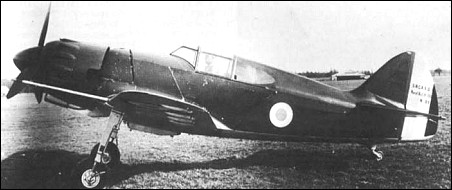|
| In 1936, the Ministere de l'Air established a requirement
for a lightweight fighter of wooden construction
which resulted in the development of the Arsenal VG
30, the Caudron C 713 and the Bloch 700. The last-mentioned
type, designed by Andre Herbemont, who
had been responsible for the Bleriot SPAD fighter
series, was built at the former Bleriot-Aeronautique
plant at Suresnes which had been incorporated in the
Societe Nationale de Construction Aeronautiques du
Sud-Ouest (SNCASO) on 1 January 1937, under the
directorship of Marcel Bloch. Of stressed-skin construction, the Bloch 700 was powered by a Gnome-Rhone 14 M614-cylinder radial engine offering 700hp for take-off and had provision for two 20mm Hispano-Suiza 404 cannon and two 7.5mm MAC 1934 M39 machine guns. The sole prototype was destroyed at Buc after capture by German forces.
 | A three-view drawing (1648 x 1255) |
| MODEL | MB.700 |
| CREW | 1 |
| ENGINE | 1 x 700hp Gnome-Rhone 14M-6 |
| WEIGHTS |
| Take-off weight | 1850 kg | 4079 lb |
| Empty weight | 987 kg | 2176 lb |
| DIMENSIONS |
| Wingspan | 8.90 m | 29 ft 2 in |
| Length | 7.34 m | 24 ft 1 in |
| Height | 3.40 m | 11 ft 2 in |
| Wing area | 12.40 m2 | 133.47 sq ft |
| PERFORMANCE |
| Max. speed | 550 km/h | 342 mph |
| Cruise speed | 440 km/h | 273 mph |
| Ceiling | 8700 m | 28550 ft |
| ARMAMENT | 2 x 20mm, 2 x 7.5mm |
| GrahamClayton, e-mail, 29.12.2024 08:08 The planned armament consisted of 2 Hispano HS404 20mm guns and 2 7.5mm MAC M39 machine guns. reply |
| Michael Allen, e-mail, 05.08.2016 09:03 It is a very interesting aircraft. But lightweight concept was a good idea. The ultimate aircraft of this cocept has to be the de Havilland Mosquito which made use of balsa wood and furniture manufacturers. It's light weight meant it was very fast and could outrun Luftwaffe fighters. The only Allied aircraft that the Germans tried to directly copy. They failed because of problems with adhesive technology. reply | | Pablo Alvarez, e-mail, 09.01.2015 21:22 Consider that not even the Italian aircraft whose average power was 840hp were able to reach 500 km /h. This says a lot about a design that has only 700hp. reply | | toja, 28.11.2013 17:22 Yak-3 wasn't "lightweight fighter", it had early Spitfire's mass and was much heavier than Bf-109d, only 10% lighter than bf-109g. reply | |
| | Klaatu83, e-mail, 02.01.2012 16:41 Before WW-II, the French really seem to have gone in for the development of the "lightweight fighter" concept more than other countries did. Unfortunately, none of them ever amounted to much.
Another examples of this concept was the Bell P-77, developed for the U.S. Army Air Force during the war, with also was a failure.
Perhaps the only really successful "lightweight fighter" of the period was the Soviet Union's Yak-3 which, ironically, ended up being flown by ex-patriot French pilots! reply |
|
Do you have any comments?
|
| 
COMPANY
PROFILE
All the World's Rotorcraft
|








20
reply